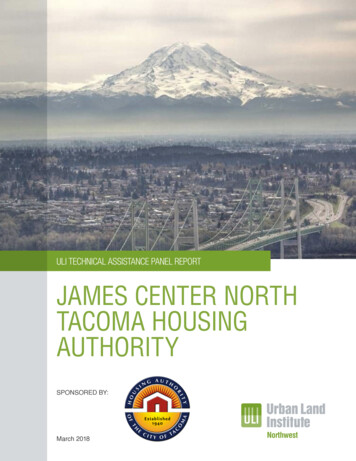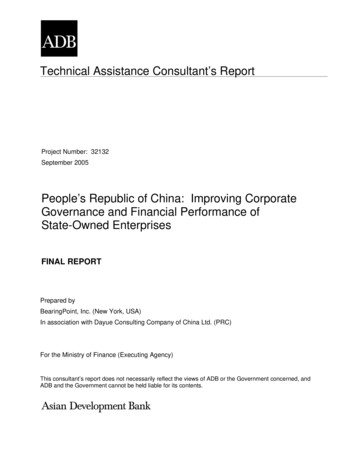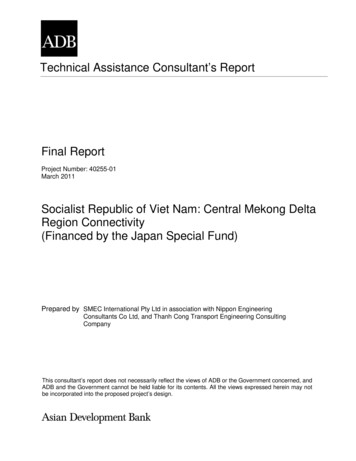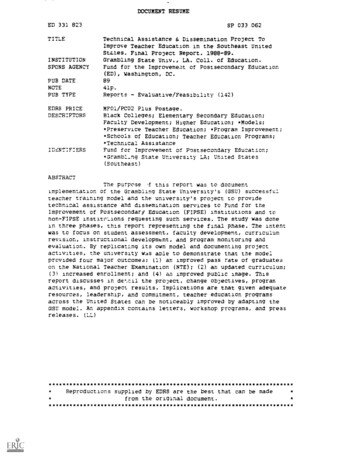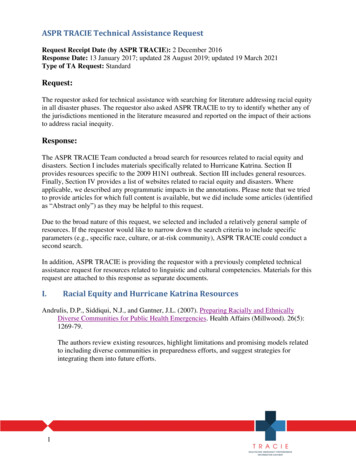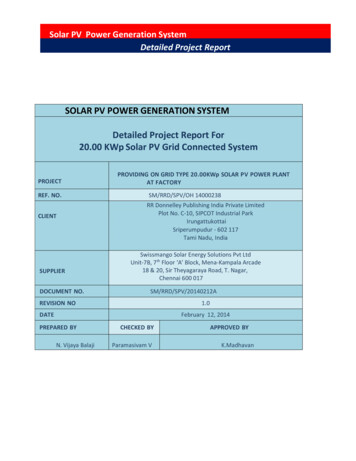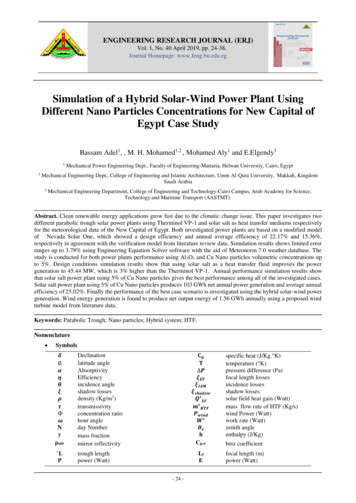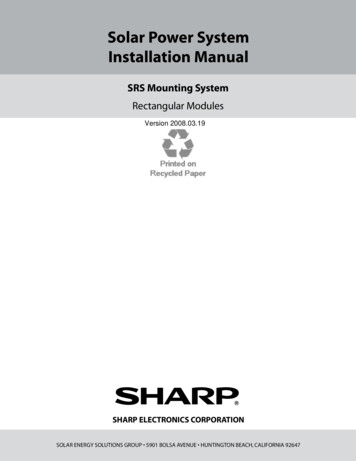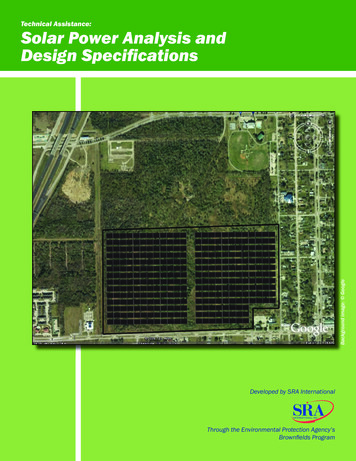
Transcription
Technical Assistance:Background image: GoogleSolar Power Analysis andDesign SpecificationsDeveloped by SRA InternationalThrough the Environmental Protection Agency’sBrownfields Program
Table of Contents1Introduction . 11.1 EPA Brownfields Program . 11.2 City of Houston Project Description. 11.3 Technical Assistance Overview . 12Task 1: Conduct On-Site Photovoltaic Project Assessment . 22.1 Site Visit Summary . 22.2 10 MW Solar Farm Footprint and Preliminary Recommendations for Site Preparation . 43Task 2: Regulatory Assessment . 74Task 3: Site Engineering Assessment . 124.1 Site Preparation Engineering . 124.2 Photovoltaic Equipment Selection and System Design Criteria. 125Task 4: Determine PV System Size, Conceptual Design Elements, and Specifications . 155.1 PV System Size Options . 155.2 Conceptual Design Elements . 155.3 PV Equipment Specifications . 165.4 PV Generation Output Analysis . 166Task 5: Develop Installed Cost Estimates for the Solar Farm. 187Task 6: Conduct Economic Analysis of the Proposed Solar Farm’s Characteristics . 198Conclusions and Recommendations . 218.1 Conclusions . 218.2 Recommendations . 23i
1 INTRODUCTIONUnder the U.S. Environmental Protection Agency’s (EPA) Brownfields Program, the City of Houstonwas selected as a Brownfields Sustainability Pilot Community. In support of this pilot, SRA International(SRA) was tasked to provide assistance to the City of Houston to provide technical and economicanalyses on a proposed solar power farm on a former landfill. This work was performed under EPAContract No. EP-W-07-023, Work Assignment 018, entitled, “Technical Assistance to PilotCommunities.”1.1 EPA Brownfields ProgramEPA’s Brownfields Program empowers states, communities, and other stakeholders to work together toprevent, assess, safely clean up, and sustainably reuse brownfields. A brownfield site is real property, theexpansion, redevelopment, or reuse of which may be complicated by the presence or the potentialpresence of a hazardous substance, pollutant, or contaminant. EPA’s Brownfields Sustainability Pilotsprovide technical assistance to support communities in achieving greener, more sustainable assessment,cleanup, and redevelopment at their brownfields projects. These pilots will also serve as models for othercommunities across the country.1.2 City of Houston Project DescriptionThe City of Houston, Texas anticipates that the revitalization of the 300-acre Holmes Road Landfill sitelocated 10 minutes from downtown Houston will create positive environmental impacts such as ahealthier ecosystem, increased safety for surrounding residents, economic development, and historicalrestoration. EPA assistance, provided through SRA, will help the city analyze the environmental andengineering issues of building a solar plant on a former landfill. SRA will also help conduct solar energyproduction and financial feasibility studies. The redevelopment of the city-owned landfill site into a solarfarm will help spur a viable local market for solar energy systems and lead to the creation of the jobs.1.3 Technical Assistance OverviewThe technical assistance provided to the City of Houston was designed to provide analysis support in theareas of environmental review, preliminary engineering design, solar photovoltaic (PV) systemconceptual design and specifications, solar farm turn-key costs, solar system output, and economicvaluation. In completing these tasks, the goal was to provide the city with current and accurateinformation on the costs and benefits, and regulatory requirements for building a solar farm on a formerlandfill owned by the city. Specifically, the analyses completed under this study were performed throughthe following seven tasks: Task 1: Conduct on-site photovoltaic project assessmentTask 2: Regulatory assessmentTask 3: Site engineering assessmentTask 4: Determine PV system size, conceptual design elements, and specificationsTask 5: Develop installed cost estimates for the solar farmTask 6: Conduct economic analysis of the proposed solar farm’s characteristicsTask 7: Develop a final report1
These tasks were completed by SRA with assistance from City of Houston personnel, EPA staff, andsubcontractor, Tetra Tech, Inc. All information and analyses provided in this report are based upon dataprovided by project participants, industry standard costs and modeling procedures, and current regulatoryrequirements. The information and results presented in this report may be subject to change based onchanges in market conditions, regulatory or legislative initiatives, and/or technology advances.The following sections detail the scope of work elements completed in support of this project, as well asprovide recommendations for next steps towards solar project development and power purchaseagreement negotiation and finalization.2 TASK 1: CONDUCT ON-SITE PHOTOVOLTAIC PROJECT ASSESSMENTSRA personnel travelled to Houston on August 18 and 19, 2008 to kick off the solar analysis projectthrough meetings with City of Houston staff and a site visit to the Holmes Road landfill. A detailed sitevisit report was submitted on October 16, 2008; this report is briefly summarized below.2.1 Site Visit SummarySRA and City of Houston staff conducted a site visit of the Holmes Road Landfill on August 19, 2008.The site was visible on three sides from the road, but was not accessible via auto, and only small portionswere accessible by foot. The site was capped in the mid 1970s and is heavily overgrown with large treesand brush (see photos 1 and 2 below).Photo 1. Holmes Road Landfill from Sunnyside Park2
Photo 2. Holmes Rd. Landfill–Abandoned Road (Incinerator Dr.) Cutting through Middle of ParcelDue to the severe overgrowth at the landfill site, SRA and City of Houston staff were unable to physicallywalk the site. However, several observations were able to be made by driving around the site on the sidesaccessible by road. The site is bordered on the north by Bellfort Street, on the west by Comal Street, onthe south by Reed Road, and on the east by Highway 288. There is a police station and library near thecorner of Comal Street and Reed Road, and Sunnyside Park is on the corner of Comal Street and BellfortAvenue.While utility distribution lines are adjacent to the landfill site on three sides, the north and west sides ofthe landfill had significantly smaller distribution lines which were estimated to have a lower carryingcapacity than the larger line on the south side of the landfill running along Reed Road. Furtherinvestigations will be necessary to determine both the load carrying capacity of the line on the southernside of the parcel, as well as the available capacity on the line. This information is necessary to determinehow much capacity can be added to the distribution line from a proposed solar power farm, and if the linewill need to be upgraded to accept planned and potential future levels of power from the site.The site will need to be cleared and graded. Clearing and grading of the site will require consideration tonot disturb the landfill cap, and avoid any potential areas with lead contamination. Based on the TerraconEnvironmental Site Investigation Report, there is only one known area contaminated by lead. Initialestimates obtained by the city indicate a cost of 7,000 per acre to clear the landfill area to be designatedfor solar farm development.3
Based on the site visit, SRA has determined that the land best suited for solar farm development roughlycomprises the southern half of the Holmes Road Landfill. This is due to a number of reasons, including: The higher capacity distribution line parallels Reed Road on the southern edge of the property; thusthe interconnection site to the utility grid would be at the southern edge of the property.Since the solar panels need to be facing south, siting them adjacent to Reed Road on the southernedge of the property will eliminate any potential solar obstructions, as well as eliminate the need toclear additional land as a buffer zone to clear solar obstructions. Alternatively, if the solar farm weresited on the northern portion of the landfill, a buffer zone would need to be cleared south of the solarfarm to eliminate obstructions from the tall trees and overgrowth existing at the site. Reducing theamount of land that needs to be cleared and graded will also reduce overall project costs.Siting the solar farm on the southern half of the landfill also provides increased visibility of the solarpanels to the public, thereby providing increased public relations benefits. Vehicle traffic on ReedRoad will see the front of the panels, which are much more aesthetically-pleasing than the back of thepanels. Conversely, siting the farm on the northern half of the landfill would allow drivers on BellfortStreet to only see the back side of the panels. Perhaps more importantly, siting the project on thesouthern half of the landfill and along the edge of the eastern boundary of the site will make the solarfarm highly visible to traffic along Highway 288, an elevated and heavily travelled route.While the solar farm will be required to have a security fence, solar panels are prone to theft,particularly during periods of increasing electricity costs. Siting the solar farm on the southern half ofthe landfill will place it adjacent to the local police station, and provide an enhanced level of securityand safety.Siting the solar farm on the southern half of the landfill will not disturb the “urban forest”–typeboundary around Sunnyside Park. The edge of the landfill property surrounds the park and provides anatural boundary of trees and overgrowth which acts as both an aesthetic backdrop and a noise barrierfrom Highway 288.Even though the landfill area was inaccessible by foot, the site visit was an extremely beneficial exercisein terms of determining probable electrical interconnection points, the “best fit” siting of the solar farmbased on the property and surrounding area’s characteristics, and the preliminary engineeringrequirements and design characteristics necessary for the project.2.2 10 MW Solar Farm Footprint and Preliminary Recommendations for Site PreparationBased upon a review of existing data and research reports, the site visit, and on-site discussions with Cityof Houston staff, a number of initial conclusions and recommendations can be made as part of the sitevisit analysis. First, it is recommended that the solar farm be sited on the southern portion of the HolmesStreet Landfill. Second, based on discussions with city management, and their interest in developing thesite with amorphous silicon (A-si) solar panels from an Applied Materials (AMAT) or equivalentmanufacturing line, it was possible to develop an approximate footprint of the proposed 10 MW solarfarm. Currently, amorphous silicon solar panels produced from the current generation of the AppliedMaterials manufacturing line have conversion efficiencies in the 6-7.5 percent range. These modules arelarge, utility scale panels with dimensions of 2.2 x 2.6 meters, and would be mounted with a fixed tilt of30 degrees if designed to maximize for annual energy production. Based on these assumed efficienciesand mounting structures, 1 MW of solar PV would require approximately 15 acres of land to account foradequate spacing between rows to avoid row-on-row shading, as well as account for inverter pads and4
other balance of system components. 15 acres per MW is an approximate estimate based on currentlyavailable and known information, with the final dimensions to be determined in the design-build process.Thus, a 10 MW solar farm at the landfill would require approximately 150 acres, or half of the landavailable at the site. Figure 1 on the next page provides the recommended footprint for the 10 MW solarfarm. This is a preliminary recommendation, and final dimensions should be determined during thedesign-build process to account for exact module efficiencies, row spacing, and site preparationconsiderations.With respect to site preparation, it will be necessary to clear and grade the site. Clearing
The technical assistance provided to the City of Houston was designed to provide analysis support in the areas of environmental review, preliminary engineering design, solar photovoltaic (PV) system

